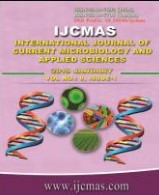


 National Academy of Agricultural Sciences (NAAS)
National Academy of Agricultural Sciences (NAAS)

|
PRINT ISSN : 2319-7692
Online ISSN : 2319-7706 Issues : 12 per year Publisher : Excellent Publishers Email : editorijcmas@gmail.com / submit@ijcmas.com Editor-in-chief: Dr.M.Prakash Index Copernicus ICV 2018: 95.39 NAAS RATING 2020: 5.38 |
The present investigation were undertaken to evaluate the intergeneric population of Carica papaya (Arka Surya) and Vasconcellea cauliflora for PRSV tolerance. The morphological traits viz., plant height at flowering (60 to 172 cm), plant height at first harvest (127 to 194 cm), stem circumference at flowering (14 to 30cm), stem circumference at first harvest (26.8 to 54cm), canopy spread (N-S, E-W) at flowering (98 to 193 cm, 94 to 188cm), canopy spread (N-S, E-W) at first harvest (130 to 237 cm, 128 to 234 cm) were more in intergeneric progenies compared to the male parent Vasconcellea cauliflora. Maximum fruit weight was recorded in the progeny (S6-3) and the minimum weight was recorded by the male parent Vasconcellea cauliflora. The maximum fruit length, width, pulp thickness (cm), fruit volume (ml) and fruit cavity index (%) was recorded with progenies likeS11-4, S1-10, S6-2, Vasconcellea cauliflora respectively and also the maximum total soluble solids, vitamin C, acidity, total carotenoids, lycopene, and total sugar was recorded with progenies like S12-15, Vasconcellea cauliflora, S9-23 and S10-21, respectively. The highly susceptible progeny S2-2 registered the highest peroxidase activity and the resistant male parent (Vasconcellea cauliflora) recorded the lowest value. Total phenols recorded among the progenies varied significantly and ranged from 311.87 to 628.59 mg 100g-1 FW. Based on overall evaluation of F5 population, two progenies (S6-1 and S6-2) can be advanced to F6 generation for further evaluation.
 |
 |
 |
 |
 |